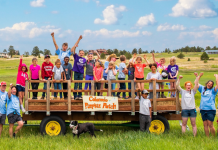
At the Colorado Department of Human Services’ Office of Early Childhood, we recommend that you talk about safe sleep practices with everyone who provides care for your baby, including your child care provider, the sitter down the street and even your own parents.
As new parents, we read all the books, blogs and brochures we can get our hands on about how to keep our kids safe, from installing the car seat and introducing solid foods to using sunblock and preventing Sudden Unexpected Infant Death (SUID) or Sudden Infant Death Syndrome (SIDS).
In today’s world, we have the benefit of collective years of experience of other moms at our fingertips with social media, as well as the benefit of current research to inform and guide our decisions as parents. We are inundated with information on how to keep our kids safe.
Now, imagine doing this parenting thing twenty, thirty or forty years ago before all this research was done – and before social media and mom blogs. Babies rode in boxes on the floor of the car; solid foods were introduced when babies were just a few months old; kids played outside all day long without regard for sunblock; and babies were put to sleep on their stomachs. Just like the parents of today, our parents did the best they could with the information they had at the time.
But that information has changed – dramatically.
So how do you bridge the gap when your parents have now become grandparents amidst new guidelines, but still hold some old beliefs about what is safe for your new baby?
You have that (sometimes uncomfortable) conversation.
Tips for Talking to Grandparents About Today’s Safe Sleep Guidelines
As a parent myself, I know it can be uncomfortable talking to your parents or your in-laws about the importance of learning today’s infant safe sleep practices. But trust me, it’s worth it. According to the National Institutes of Health (NIH), health education has led to about a 50 percent decrease in SIDS in the United States. That statistic is quite a compelling reason to share these changes in best practices.
Here are a few tips to guide you through that important conversation with your baby’s grandparents.
- First, do your research. To ensure you are sharing current, accurate information, start by reviewing the latest safe sleep practices from reputable, trusted sources, such as Colorado Shines’ guide to safe sleep for babies, including tips on talking to caregivers about safe sleep practices. You can even watch a video here about talking with grandparents about safe sleep practices for your baby.
- Clearly communicate and demonstrate the new safe sleep guidelines. Acknowledge that practices have changed over the years as new research has identified ways to keep babies safer. Then share those specific safe sleep practices, such as avoiding second- and third-hand smoke, removing pillows and blankets from the crib and placing baby on her back every time.
- Invite them to practice. Hand baby over and allow them to practice fastening the sleep sack and placing him on his back in the crib or bassinet. For many people, hearing it and then actually practicing it will help reinforce the information.
- Encourage them to ask questions. Taking an open, non-judgmental approach may help them feel comfortable asking questions. It is important to use your research to answer questions and clarify anything that was unclear. Make sure grandparents know they can always ask further questions and consider providing additional resources to refer back to after your conversation like the Colorado Shines safe sleep tips.
We’d love to see your baby’s grandparents’ safe sleep practices in action! Share a photo for our Safe Sleep Awareness Month photo contest this October. Winners will get to select a nonprofit organization to receive up to $1,000 in grant funds to support families and prevent child maltreatment.













